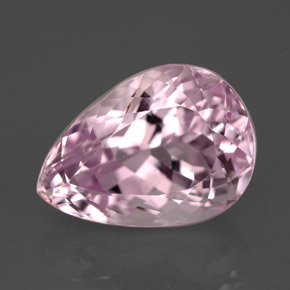The Gemstone Kunzite

Kunzite is the pink to light purple gem variety of the mineral Spodumene. Spodumene is a common mineral, but only in several localities does it occur in transparent gem form. The main gem form of Spodumene is Kunzite, the other is the rarer Hiddenite. Yellow and colorless gem forms of Spodumene also exist, but are not commonly faceted as gemstones. Kunzite has a lovely pink color and is becoming increasingly popular in the gemstone market.
Chemical Formula
?
LiAlSi
2O
6
Mineral Class
?
Spodumene
Additional Properties
|
Refractive Index
?
1.66 - 1.68 |
Double Refraction
?
.015 |
Transparency
?
Transparent |
SG
?
3.1 - 3.2 |
Luster
?
Vitreous |
| Cleavage ?
1,2 - prismatic |
All About
Kunzite is a relatively recent gemstone, having been first discovered in the 20th century. It was first found in the
pegmatites of Pala, California, in 1902, and is named after the famous
mineralogist George F. Kunz who first identified it. Though it wasn't until the 1990's that this gemstone became a more mainstream gemstone, having been used only as a collectors gemstone prior to that time.
Kunzite is a very attractive pink gem, but is
notorious for its habit of
color fading in prolonged exposure to strong light. Although the color-fading effect is very slow, most people still prefer to wear Kunzite jewelery in the evening to avoid sunlight exposure. Kunzite is regarded as an evening stone for this reason.
Kunzite deposits are quite extensive and yield large amounts of this gemstone, thus making it very affordable. Extremely large and flawless
crystals of Kunzite have been found, and these can yield very large and flawless
faceted gemstones.
The perfect
cleavage and
splintery fracture of Kunzite makes it a difficult gemstone to
facet. It is very sensitive to knocks and will
chip if hit too hard. Kunzite is known for its strong
pleochroism,
showing lighter and more intense coloring when viewed at different
angles. For this reason, it is always cut to show the deepest pink color
through the top of the gem. The deeper pink the Kunzite, the more
valuable it generally is.
Uses
?
Although Kunzite is a relatively soft and delicate gem, and can fade after prolonged exposure to light, its appealing color makes it a popular gem. Small gems are not commonly cut from Kunzite because of its
cleavage and strong
pleochroism. It is most often used as a pendant stone and as a large decorating stone on ornamental objects. It is less commonly used in rings, necklaces, or other jewelry items where small stones are required. Less transparent stones are sometimes cut into
cabochons and beads.
False Names
?
Rose Kunzite - Synthetic pink
Sapphire.
Treatments & Enhancements
?
Most Kunzite in its natural form is very light in color. It is commonly
heat treated to intensify its color and remove brownish tones.
Kunzite Sources
?
The sources of Kunzite are Afghanistan, Pakistan, Brazil, Madagascar, Mozambique, and the U.S. (California, and Maine).
Similar Gemstones
?
Rose Quartz - Usually cloudier and less transparent.
Morganite and pink Tourmaline - Similar in color but greater
hardness.
Topaz - Greater in hardness, usually in a darker pink color tone.
Pink Spinel and
pink Tourmaline - Greater in hardness, usually deeper pink.
Kunzite in the Rough Photos
?